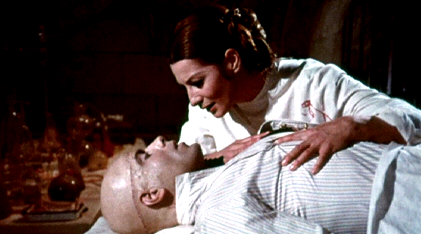Director: Paul Bartel
Writers: Robert Thom, Charles B. Griffith, adapting Ib Melchior’s original short story “The Racer”
Producer: Roger Corman
Cast: David Carradine, Simone Griffeth, Sylvester Stallone, Mary Woronov, Louisa Moritz, Roberta Collins, Fred Grandy, Don Steele (as The Real Don Steele), Joyce Jameson, Carle Bensen, Martin Kove, Leslie McRay, Sandy McCallum, Harriet Medin, Wendy Bartel, Bill Morey, William Shephard, Vince Trankina, Paul L. Ehrmann (as Paul Laurence), John Favorite (as Jack Favorite), John Landis, Sandy Ignon, Darla McDonnell, Roger Rook, Paul Bartel (uncredited), Lewis Teague (uncredited), Charles B. Griffith (uncredtited), Dick Miller (uncredited)
In the year 2000, the United States has become a totalitarian society. It provides the public the distraction and spectacle of the annual Transcontinental Road Race. The racers not only compete to traverse the country in the fastest time, but they also must score points for the kills they make by running over pedestrians. The current champion is Frankenstein (David Carradine). He is so named because of his many racing injuries and surgical reconstructions. In addition to the dangers he and the other drivers face in their sport, there are anti-government rebels attempting acts of sabotage against the race.
The Flashback Fanatic movie review
I think the film’s most pertinent point is the depiction of the manic enthusiasm of the fans for the sport and its champions. This gaudy and brutal distraction of the Transcontinental Road Race entertains and ultimately pacifies the citizens. It also cheapens the merit of human life to being worth no more than points to be scored by the racing heroes that they adore. This removes the motivation to demand that a government dedicated to “minority privilege” be responsible for the well being of all the people. The public is idiotically devoted to an entertainment they want to believe has some sort of meaning; it must if it makes them feel good, right? So long as the citizens don’t ever ask themselves what difference a winning score in a sport has to do with anyone’s quality of life, they should be happy.
The film is loosely based on an Ib Melchior short story called “The Racer.” That story also details a futuristic road racing sport that involves scoring points for running down pedestrians. It is told from the perspective of the champion racer being confronted about the morality of such real-life violence used to entertain. Death Race 2000 expands the story to include more characters and additional themes in a satirical manner.
The wild and witty screenplay is by Robert Thom along with producer Roger Corman’s inventive and humorous writing veteran Charles B. Griffith. Director Paul Bartel has always distinguished himself both in front of and behind the camera in films of bizarre comedy. While many of the characters are laugh-out-loud funny, they all seem to be appropriate to the shallow and empty world of this future dystopia.
Having just wrapped up his popular Kung Fu television series, David Carradine stars as the racing champion called Frankenstein. While nearly every other character is a loutish caricature, Frankenstein is an intriguing enigma. In public he is always hidden behind a mask supposedly to conceal his road accident scars. His manner is stoic while most of those around him are eccentric and volatile. Whether this was a writing choice, a directing decision, or just Carradine’s acting style, I think it is this restraint in an exotic character that makes him interesting and keeps Frankenstein the hub around which the rest of the story revolves.
The other standout in the cast has to be Sylvester Stallone as the hilariously belligerent racer Machine Gun Joe Viterbo. He is both funny and despicable. Being jealous of Frankenstein’s popularity, Viterbo always has a chip on his shoulder and is ready to dole out violence to anyone. Just one year later, the struggling actor Stallone would achieve lasting stardom in Rocky (1976).
Cult film favorite and frequent Paul Bartel co-star Mary Woronov appears as the racer Calamity Jane Kelly. Unlike the other characters in this film, she actually seems quite likable.
Special mention must go out to Don Steele as the obnoxious race announcer Junior Bruce. His hyperbole and gung-ho puns keep stressing the superficiality of this race and this society.
Aside from the humor, the major fun factors in this film are the attention-getting personas worked out for the racers that are complimented by the design of their vehicles. Since Frankenstein is named after a famous monster, his vehicle is called “The Monster” and is decked out like a dragon with huge fangs protruding from the front bumper. The other racers each have their own appropriately adorned cars.
At this film’s most visceral level, it provides forbidden appeal with the depiction of sanctioned vehicular homicide. There is a sense of sick liberation in the notion that one becomes a hero for violating the rules that we are conditioned to follow as good drivers and citizens. That is the main reason that Death Race 2000 became a very successful film.
Obviously concocted to cash-in on the futuristic blood sport vibe of the soon-to-be-released Rollerball (1975), Death Race 2000 approaches its subject in a much more freewheeling and humorous manner, yet it is just as thought provoking. Being an exploitation film that has themes worth pondering along with its action and laughs meant that Death Race 2000 was bound for cult status.


























